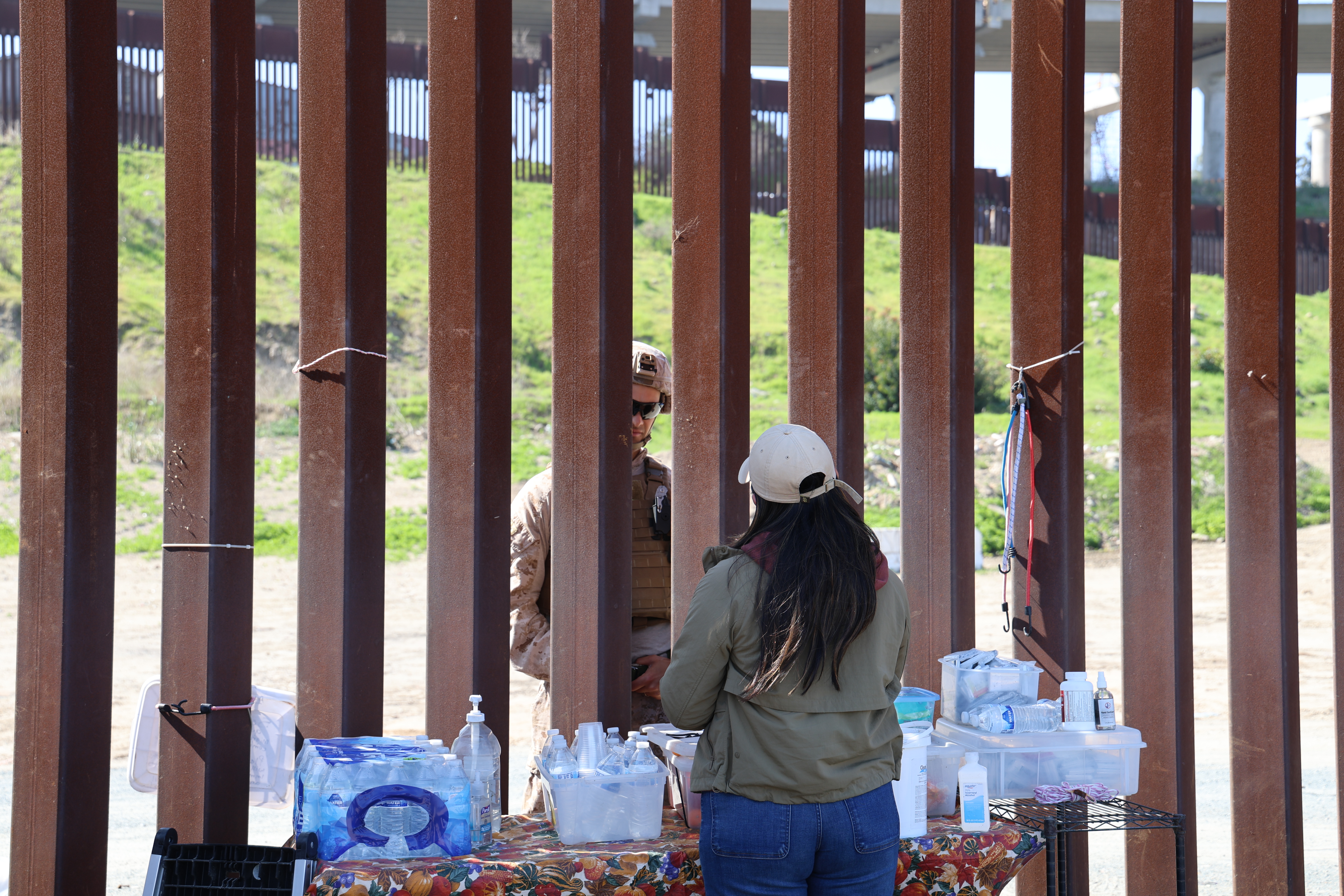
The U.S.-Mexico land border cuts through the heart of the San Diego and Tijuana regions, fracturing in two what might have otherwise existed as a single city. The vast amount of crossings each day as people go to school, work and other activities blur the harsh lines drawn in the sand regarding who belongs on either side. The border is double-walled; as people go about their business in the metropolitan sprawl on either side, immigrants are trapped in between the two barriers.
The dry strip of land in between the walls, about 100 meters wide, isn’t much more than desert shrubbery and old tire tracks from Border Patrol trucks patrolling the area. It’s no man’s land – not quite the United States, not quite Mexico. Those seeking asylum are often dropped off by Border Patrol agents at open-air detention sites between the walls and left to wait. In this Twilight Zone purgatory, it’s unclear how much time will pass before the Border Patrol agents will pick them up and take them to their final destination. Because they are not technically in U.S. custody, the migrants awaiting processing at open-air detention sites are often held without access to basic services like clean water, food and first aid.
A few miles west of the San Ysidro port of entry, one of these detention sites has been nicknamed “Whiskey 8.” Two port-a-potties and hand washing stations sit in the hot sun, and the large water tank has run dry. But on the U.S. side of the wall, tents have been set up with an oasis of resources.
The station is full of boxes of clothes, nonperishable food items and children’s toys. Water bottles and fresh oranges sit atop a table nestled right up against the towering wall. If someone was on the other side, they could reach their hand through the 4-inch gaps in the fence and grab something to drink. The site was organized by the American Friends Service Committee (AFSC), although employees and volunteers from a variety of nonprofits serve at Whiskey 8.
Among those working at Whiskey 8 is Liliana Reza, the director of U.S.-Mexico border engagement with the advocacy and policy team at World Relief.
“Part of the work that we do is to advocate for human rights,” Reza said. “There were a lot of human right violations or things that were concerning us [at the border], so being present was a form of solidarity and also a form of accountability. It was an opportunity for us to come alongside important work that was being done.”
Reza said she has been covering some of the shifts at Whiskey 8 and helping provide migrants with food, first aid and resources to prepare for their arrival in the United States. Often, Reza said, those who are dropped off at the site are disoriented and sometimes injured from their journey. This is just one component of the organization’s support for migrants in the U.S.; World Relief also provides legal services to help eligible clients apply for citizenship, asylum, DACA (Deferred Action for Childhood Arrivals), permanent residence, family reunification, work authorization, Temporary Protected Status and Special Immigrant Visas.
The San Ysidro port of entry is the busiest land border crossing in the Western Hemisphere. Many people cross daily for work and school, on top of those who are seeking asylum. On average, 70,000 northbound vehicle passengers and 20,000 northbound pedestrians are processed every day. This means that traffic can often flood Whiskey 8, and wait times can be long for those who are crossing for the first time.
“When I started, people were waiting anywhere between 10 minutes, and I remember a family who waited 12 hours,” Danielle Cosmes, who works for AFSC and takes regular shifts at Whiskey 8, said.
Cosmes started working at Whiskey 8 in June of 2024. On her first day, former President Biden issued an executive order reducing the number of people who could enter the United States seeking asylum. Since then, the numbers of people arriving each day have fluctuated, which she said is often due to policy changes.
Most recently, Whiskey 8 has seen a sharp decline in the number of people being sent to open-air detention sites, likely due to President Trump’s administration’s crackdown on immigration. The last group of migrants they saw arrive was on Feb. 15; the open-air detention site at Whiskey 8 has remained empty since then.
“The current administration is building on that legacy of an asylum ban and basically eviscerating the asylum system in the United States,” Cosmes said. “And then there’s also other factors that we don’t fully understand, like the decisions the folks on the other side are making for their own safety to maybe not cross right now, to cross in another area, or just to wait in Tijuana.”

This change in border landscape coincided with a change in weather conditions, which nearly destroyed the aid station. Recent rain and heavy winds damaged two of three tents set up at Whiskey 8, so volunteers have been spending time consolidating food and clothing items that remain intact into one tent. Previously, the area consisted of three large tents: two for storage and one as a “hospitality station.” Now, one tent remains for storage, and the hospitality station table remains uncovered.
Emma Starkey, a student at the University of California San Diego, regularly volunteers at Whiskey 8. After the U.S.-Mexico border program coordinator from AFSC gave a presentation in her global borders class, she decided to visit the site.
“My first day I ever came, we had, like 150 people [arrive],” Starkey said. “It was like, the most chaotic moment of my life. I felt useless here. But as I spent more time, I’ve figured out it’s just about being a smiling face.”
Starkey frequently works at the hospitality station, making coffee and Cup Noodles in the mornings. Occasionally, she helps with first aid, but she said she spends most of her time at Whiskey 8 having conversations.
“I have a lot of really fun interactions where people are on their daily Duolingo streak trying to learn English, and they want to practice, and they ask how to talk about football or something,” Starkey said.
She said she expected there to be changes in January once the Trump administration rolled out new policies, but it still feels surreal to have a sharp drop in migrants who are crossing and stopping at Whiskey 8.
“I think we never meant for this place to be permanent, but it felt like this was like a place you could always rely on,” Starkey said. “It felt like a place to stand up for what you believe in, like the people within this space were always aligned with your beliefs. It came to really symbolize for me a sort of resistance against the wall.”
Another new presence at the border is 1,500 active-duty personnel from the U.S. Army and Marine Corps that were sent by the Trump administration to support the work of the U.S. Customs and Border Patrol at the southern border. A U.S. Marine approached Whiskey 8 from the other side of the wall, claiming that he had been sent to set up an extensive amount of barbed wire along the wall.
He asked Reza many questions about the volunteers at Whiskey 8, the first being, “Are you guys condoning illegal activity here?”
Reza assured him that they aren’t there to help people cross; they’re there to give them the basic tools they need to survive. He was curious if people try to cross near this area because they know Whiskey 8 has food, water and language services. Reza explained that often, people are dropped off by CBP agents and told to wait. He was surprised that people often show up with life-threatening injuries and even more surprised to learn that the water tank at the site had been dry for a while now.
“We just want to make sure everyone gets treated in a humane way,” Reza said.
He agreed with her, quickly reassuring everyone at Whiskey 8 that he shared that same goal.
“Well, I don’t really think more barbed wire communicates that,” Reza replied.

